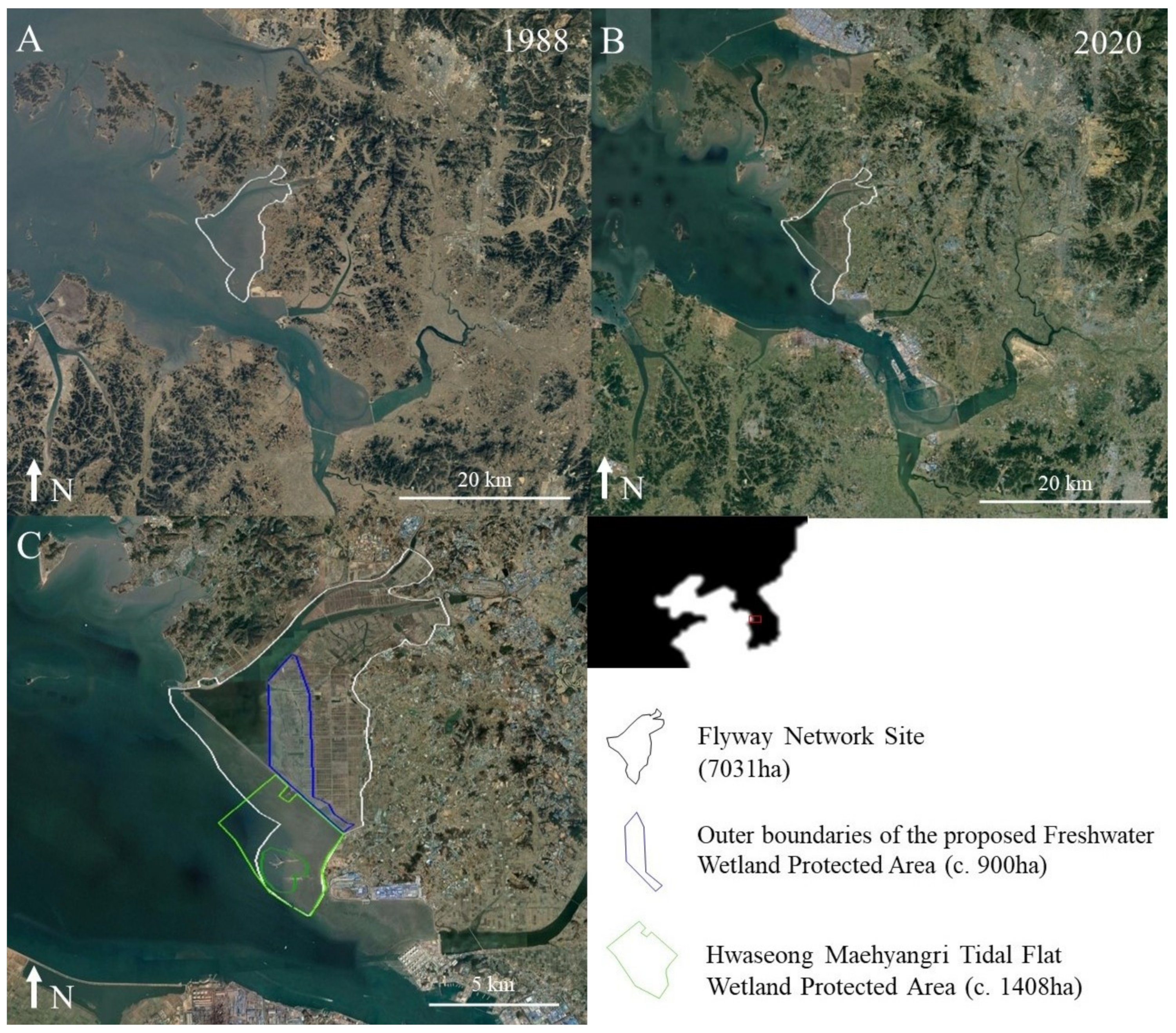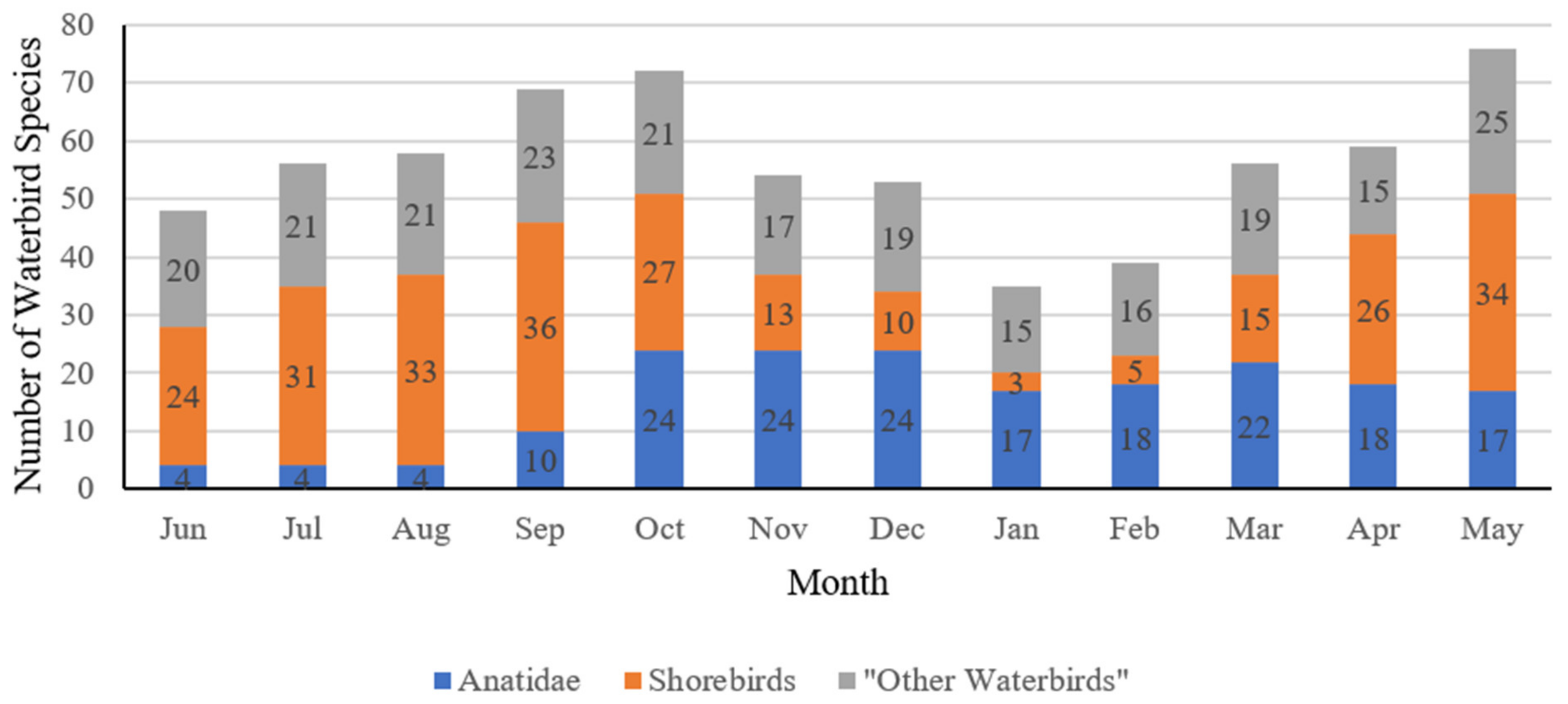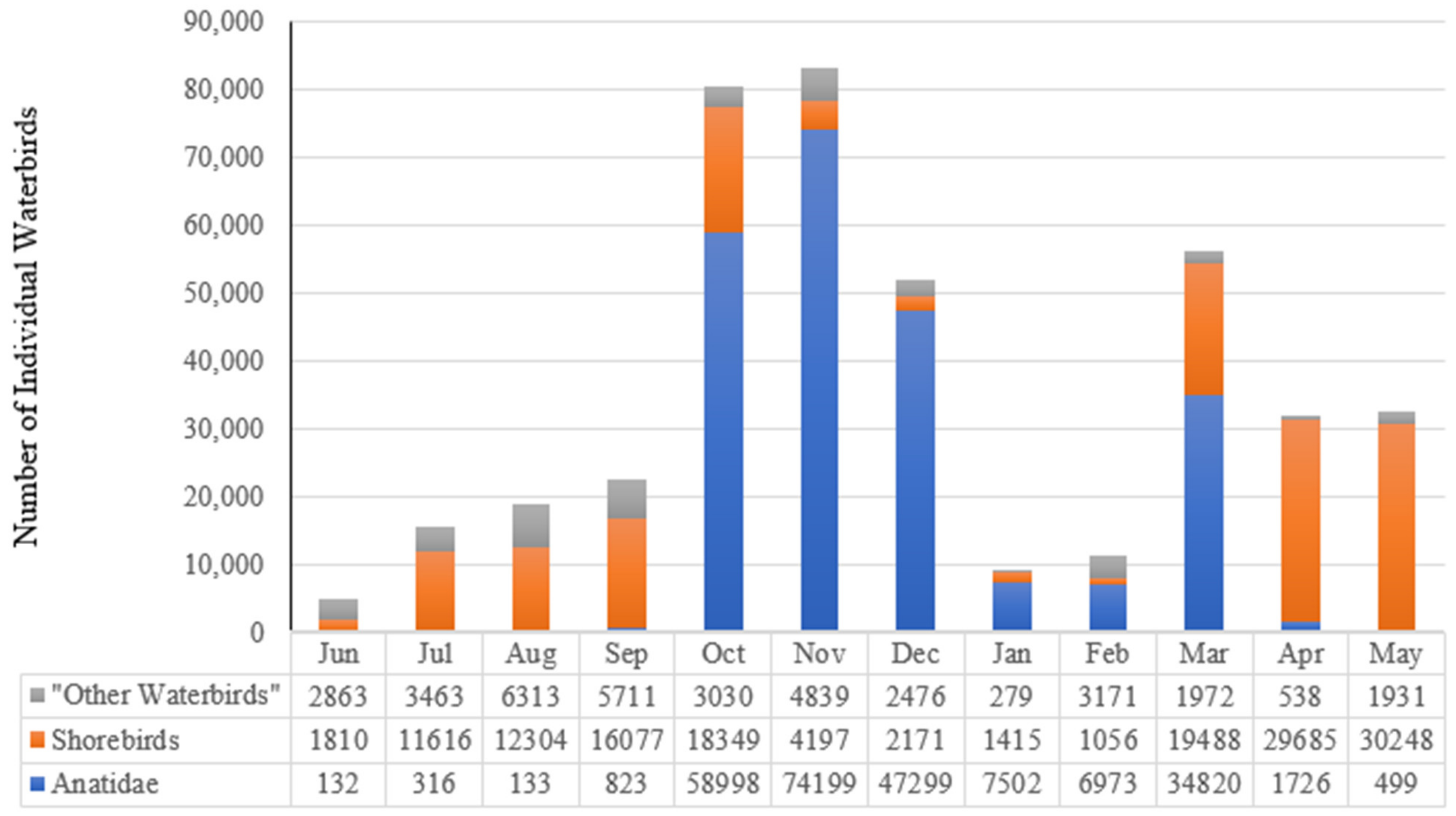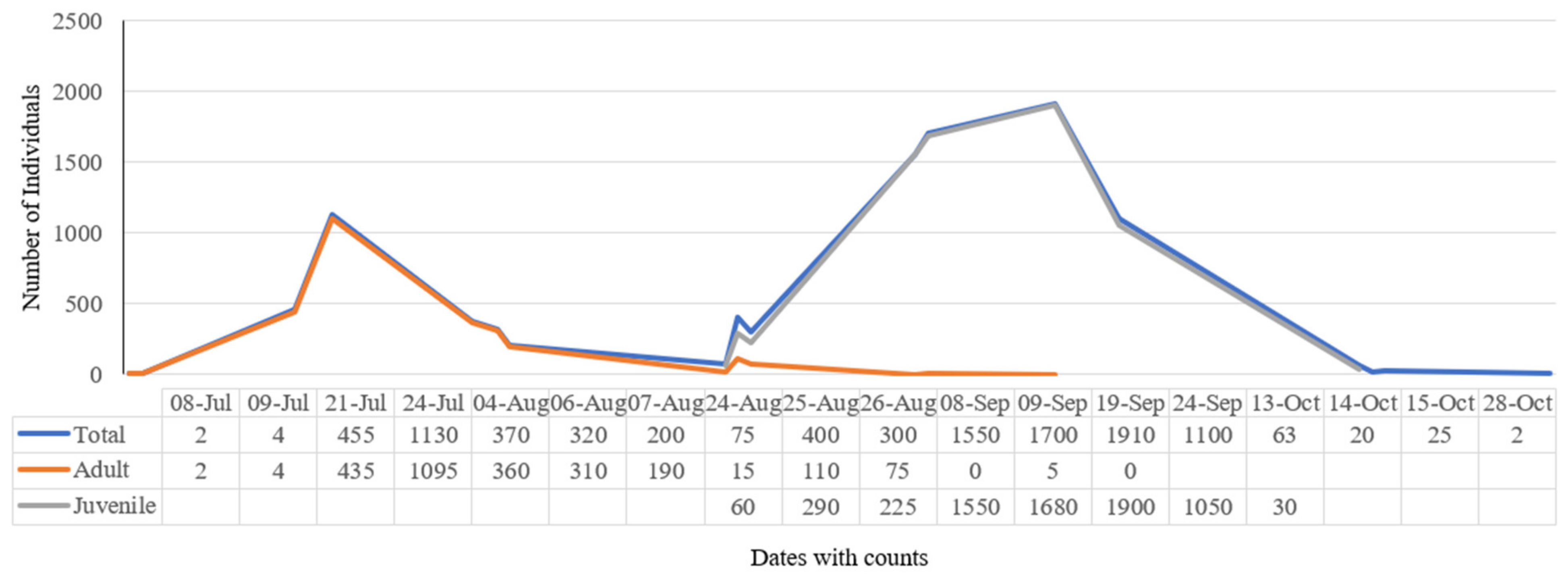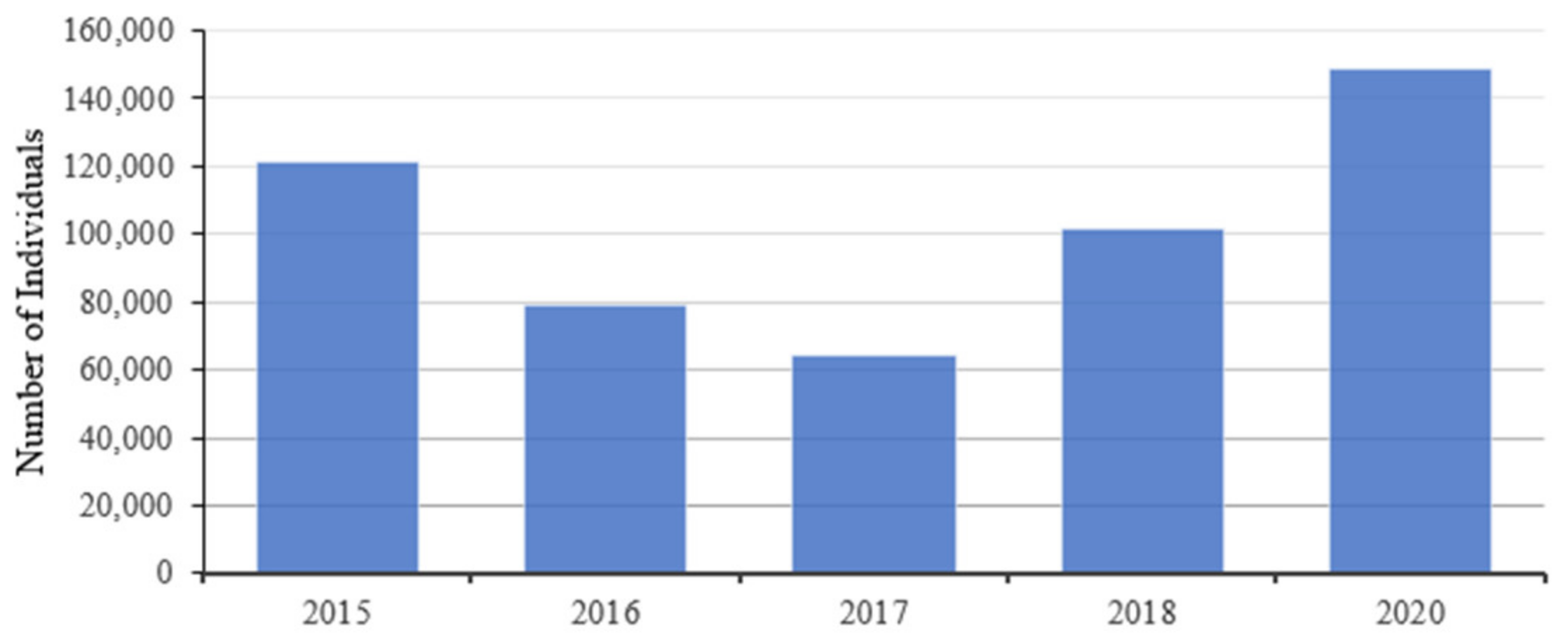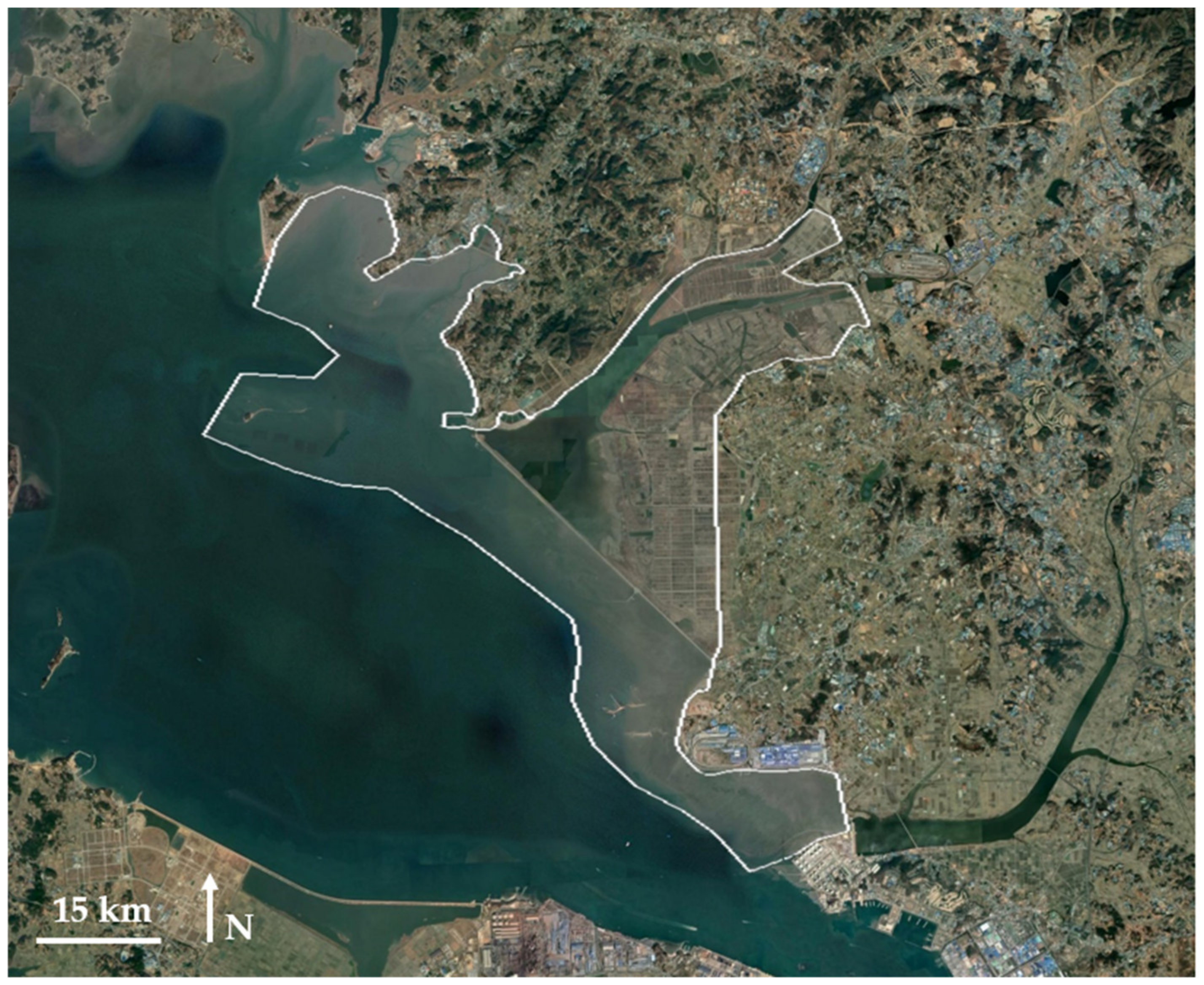2. Methods
2.1. Site Description
The Hwaseong Wetlands experience sub-zero minimum temperatures and little precipitation in mid-winter, and substantial precipitation with maximum temperatures reaching >30 °C during the summer months (
https://www.accuweather.com/en/kr/hwaseong; accessed on 1 September 2022). As with most large reclamation areas on the Korean Peninsula, the deeper parts of the bay landward of the seawall have been impounded to form a large reclamation lake, containing c. 650 ha of permanent water and 200–335 ha of seasonally inundated sand and mud lake-edge and vegetated feeder streams, all of which typically freeze over in mid-winter. The higher parts of former tidal flat have been converted to single-harvest rice-field (c. 1200 ha), while most of the remaining land, currently fallow, is also being converted to agriculture. As part of drainage and water treatment, c. 540 ha has also been given over to permanently wet freshwater reedbeds and ponds. Seaward of the outer dyke, the Hwaseong-Maehyangri Tidal Flat (c. 1000 ha) is contiguous with the Hwaseong Seokcheonri Tidal Flat (1100 ha exposed at lowest tide) to the southeast. Immediately north of the FNS within Hwaseong City there are also c. 2000 ha of tidal flats at low tide, surrounding Tori Island and stretching between Gungpyeong, Maehwari and Songgyori (from here-on, the “Maehwari Tidal Flat”), with a high tide roost during neap tides at 37.156389° N, 126.683889° E.
Waterbird counts in the 2000s and increased survey effort from 2015 confirmed that there were large declines in some species of shorebird following seawall closure in 2002 within the former Namyang Bay. However, large numbers of shorebirds which foraged on the remaining tidal flat started to use the exposed margins of the reclamation lake for roosting. During the same two decades there were also substantial increases in many species of anatid, especially geese [
35,
42], as at many other large reclamation areas in the ROK which were also impounded in the 1990s and early 2000s [
21,
43]. This is because the reclamation lake and newly-created rice-fields provided increased opportunities for undisturbed roosting and foraging, respectively, by waterbird species which were historically largely ecologically dependent on freshwater floodplain wetlands.
2.2. Bird Surveys
In this case, 58 dates of bird surveys and coarse mapping of additional wetland species in the Hwaseong Wetlands FNS and at two adjacent wetlands were conducted by one main researcher, supported by between one and four additional participants between 23 June 2020 and 27 May 2021, in effect covering the annual cycle of a waterbird (“main surveys”). In addition, 18 dates of survey (“supplementary surveys”) were also conducted between June and November 2021, including a substantially increased survey effort of the Maehwari Tidal Flat (
Table 1).
The surveys were divided into 23 periods of between one and six days each (“survey periods”). Each of the surveys entailed direct counts of waterbirds, using high-quality binoculars and tripod-mounted telescopes, in accordance with published guidance on waterbird survey protocols (e.g., Wetlands International 2010 [
44]). Since the surveys included shorebirds and threatened waterbird species which forage on tidal flats, most survey periods were timed to coincide with spring high tide series (with heights and times of tide taken for the nearby Pyeongtaek Port from
http://www.khoa.go.kr/swtc/main.do; accessed on 1 September 2022). During both the main southward migration period (from July to mid-November) and the main northward migration period (from early March to late May), survey periods were therefore spaced approximately two weeks apart, with the exception of late April 2021 which was missed due to logistical issues. The surveys conducted in June 2020 and 2021 were focused on breeding birds and were less tide-dependent.
During the initial survey in June 2020, all of the FNS was surveyed, and nine main habitats were identified and mapped coarsely. Optimal locations for conducting count points and walking or driving transects were also identified. In order to improve understanding of waterbird distribution all counts were then organized into these main habitats, further divided into 39 individually numbered “sub-units” within the FNS itself, e.g., 1--1, 4--1 etc., with additional “sub-units” outside of the FNS in immediately adjacent areas (
Figure 2). The boundaries of each of the sub-units were not drawn. This is because they were not designed for sampling and extrapolation of numbers of birds, but rather for better identifying the location of major concentrations of species by time of day, tide or season. Moreover, changes in water levels in the reclamation lakes meant that some of sub-units shifted position seasonally (e.g., 2--1 and 3--1), while construction work also converted some of the FNS from fallow grassland to reed-bed during the survey.
Our surveys were designed to try to maximize counts of waterbirds, while striving to reduce the likelihood of double-counting. On each date of survey, all observations were organized by time and sub-unit, with notes taken on the direction of movement of flying birds. At the end of each day, highest counts were then selected with “obvious” double-counted birds omitted. For example, geese seen during the day foraging in rice-fields were assumed to have been counted already flying out of roost; and in the absence of simultaneous counts, counts made of shorebirds on the tidal flat during the incoming tide were also assumed to be the same birds as those seen at roost along the edge of the reclamation lake at high tide. At the end of each 1- to 6-day survey period, only the highest single day-count of each waterbird in that period was then selected for analysis.
Count method varied for each of the three main groups of waterbirds. Since they were dispersed at low tide, tidal flat obligate shorebirds were primarily counted within two hours of high tide when birds were concentrated near or at roost; with counts on multiple dates also made of birds flying to and from roost. During all of the survey periods, counts of roosting shorebirds were made multiple times, both on the same date and on subsequent dates.
Two main approaches were used for counting Anatidae. To reduce the likelihood of double-counting, ducks were counted on a single date throughout the day within each survey period along a circuit around the FNS, either as they fed or roosted. Geese were counted primarily at dawn from one or more fixed points, as flocks departed their roost, with additional counts made at other times of the day in order to determine the ratio of each taxon. Where possible, counts of geese were repeated on consecutive dates to improve accuracy.
Most “Other Waterbirds” were counted opportunistically, during counts of Shorebirds and Anatidae, with the exception of tidal flat obligate species such as the globally Endangered Platalea minor which was actively searched for. Surveys were therefore comprised of a combination of fixed-point counts of birds out on tidal flats and in open wetlands and also of birds seen along transects, either driven or walked through, in areas of reedbed and rice-fields, when some additional shorebirds and Anatidae were also found. We therefore consider that the data are likely to be most robust for tidal flat obligate shorebirds; and least robust for “Other Waterbirds” (with substantial undercounting of some species possible).
Landbirds were counted opportunistically and irrespective of distance, with the exception of the globally Near Threatened and nationally Endangered Emberiza yessoensis in the breeding season. Most species and most individual landbirds were either seen during surveys from a moving car or their presence was determined on the basis of their vocalizations.
Survey of amphibians and mammals was also largely opportunistic too. However, on 26 June 2020, we surveyed amphibians in rice-fields and other wetland areas matching the ecological requirements of species potentially present at the site for five hours after sunset, following the protocol from Borzée et al. [
23]. This survey was repeated from dusk on 23 June 2021 until dawn of the 24 June, with estimates of the numbers of calling amphibians made in several of the sub-units.
2.3. Data Analysis
Based on the survey sub-units, data were then organized for the FNS as a whole, by main habitat type, and for the Tidal Flat WPA and the Proposed Freshwater WPA, to identify species which meet the most-often used Ramsar criteria [
39,
40] for waterbirds in each of the four categories. Criterion 2 is focused on globally threatened species and communities; Criterion 5 is focused on abundance (“regularly supports 20,000 or more waterbirds”); and Criterion 6 is often used by wetland managers to help identify conservation priorities (“regularly supports 1% of the individuals in a population of one species or subspecies of waterbird”). Criterion 4 “A wetland should be considered internationally important if it supports plant and/or animal species at a critical stage in their life cycles, or provides refuge during adverse conditions” is often also applied in Ramsar Information Sheets for sites with large numbers of migratory waterbirds [
46].
“Regularly” is defined by the Ramsar Convention as the geometric mean of five-years of count data, if data are available [
47]. As presented in the Discussion, our surveys only covered part of 2020 and 2021. We therefore incorporated count data from 2015 to early 2020 generated during survey of all bird species on one date each month between October and March by the National Institute of Biological Resources [
48] within the Ministry of Environment; of shorebirds and selected waterbirds made during the main shorebird migration periods on one date each month for 2–5 h close to high tide by the NGO, Hwaseong KFEM (unpublished data); and one reviewed record each of
Tadorna ferruginea and
Calidris tenuirostris in 2018 by Birds Korea members extracted from the global database eBird.
Since the Hwaseong KFEM counts in 2019 were incomplete, we omitted that year, and selected the highest count of each waterbird species during each of the years 2015, 2016, 2017 and 2018. For 2020, we selected the highest count from NIBR for January–March and Hwaseong KFEM counts for April and May and our own counts for June to December. Although this method is imperfect, with different methods and time available for each survey type, the resultant data suggest a reasonable consistency in both species composition and proportionate abundance making them suitable for developing 5-year geometric means for the majority of waterbird species.
2.4. Supplementary Surveys for Boundary Recommendations
Waterbird movements are important to define the spatial requirements of species and delineate protected areas. We therefore also conducted surveys of waterbirds in tidal flats to the northwest and southwest of the FNS along the Hwaseong Coast. Counts of waterbirds were conducted on 17 dates between June 2020 and August 2021 on the Maehwari Tidal Flat, i.e., along the Hwaseong coast northwest of the FNS. Most of our survey effort was concentrated in a bay used for roosting shorebirds during neap tides.
Full counts were made on only six dates of the Hwaseong Seokcheonri Tidal Flat, to the southwest of the FNS. Tidal flats extend for about 1050–1100 ha at lowest low tides and are contiguous with the south-eastern boundary of the Tidal Flat WPA. Due to the loss of upper tidal flat areas to reclamation, the whole of this tidal flat is inundated on tides above c. 8 m and there are no roost sites for most shorebird species. Due to the comparatively low survey effort, these surveys likely substantially underestimated the number of waterbirds present at these two sites.
4. Discussion
Our research confirms the international importance to migratory waterbirds of the Hwaseong Wetlands FNS. Between June 2020 and May 2021, we recorded 113 species of waterbird within the FNS as a whole. This is 12 waterbird species more than stated to be within the four sites currently designated as the Getbol, Korean Tidal Flat World Heritage Property [
57]. During the main surveys, 25 waterbird species were counted in internationally important concentrations of 1% or more of their population; and several additional globally threatened wetland species were found within the FNS. We also recorded more than 150,000 waterbirds during a one-year cycle. This number is higher than the total number of waterbirds said to be present in the Getbol, Korean Tidal Flat World Heritage Property as a whole in four out of seven years between 2009 and 2015 [
57].
The number of waterbirds supported by the FNS through the one-year cycle was, however, likely to be substantially higher than the 150,000 we recorded. Our surveys only covered 58 dates (i.e., we “missed” many dates even during the main migration periods), and our total is based on the summing of the single highest day count of each species, without factoring in turnover, seasonal differences in migration routes or differences in migration phenology between different populations of the same species.
For example, because of our reduced survey effort in mid-winter, our highest day count of
C. boyciana (eight) was substantially lower than counts reported by several other observers during the winter, including 26–35 recorded during government surveys [
58]. In addition, identifiable sub-species of some species peaked at different times to more numerous subspecies of the same species, including, e.g., the newly-recognized
bohaii subspecies of
Limosa limosa (69), and nominate-type
Ardea alba alba (169), both of which fell outside of the peak counts of
L. l. melanuroides, and of the East and South-east Asian non-breeding population of
A. a. modesta. As such, their presence was not reflected in the totals.
As at other Yellow Sea sites, our data also suggest that many migratory waterbird species in the FNS have asynchronous migration strategies. These differences in migration strategies are perhaps most obvious during the southward migration of shorebird species, when males, females and juveniles of the same species can peak in number at the same sites at different times [
59,
60]. For example, in July, we recorded a peak of 1310
Calidris ruficollis, all of which appeared to be in adult or Second Calendar-year type plumage. In September, we counted 1910, all of which appeared to be in fresh juvenile plumage. We can therefore be confident that more than 3200
C. ruficollis were present in total in the FNS during the southward migration period in 2020 (
Figure 5 and
Figure 6). In addition, we also recorded a peak of 450
C. ruficollis during northward migration in 2021. Since we did not see any with individually marked flags or bands, we cannot know whether any or all of these 450 individuals were additional birds. At least some
C. ruficollis are considered to take a different route during northward and southward migration (e.g., [
61]).
The data gathered by NIBR and Hwaseong KFEM for years 2015, 2016, 2017, 2018 and early 2020 were not organized into the same survey sub-units. It is therefore not possible to use them to assess the international importance of each of the component parts of the Hwaseong Wetlands FNS. However, they can be used to confirm that each year the Hwaseong Wetlands FNS regularly supported waterbirds in concentrations that exceeded 20,000 individuals, and internationally important concentrations of 1% or more of many of the same waterbird species every year (
Figure 7).
In four of the five years, single day counts of one or more waterbird species alone exceeded 20,000 individuals, and the five-year geometric mean of waterbirds counted each year within the Hwaseong Wetlands in 2015–2018 and in 2020 was 98,607 individuals—almost five times the threshold of 20,000 called for in Ramsar Criterion 5. In total, the geometric mean of 16 populations of waterbirds met the 1% threshold in years 2015–2018 and in 2020 (
Table 7). Application of Ramsar criteria therefore allows for the identification of at least 21 species of waterbird (16 under Criterion 6 and an additional five under Criterion 2) and of four additional wetland species (under Criterion 2) as internationally important conservation priorities within the FNS.
Importantly, our research also confirmed daily movements of waterbirds between foraging and roosting areas within various component parts of the FNS, and also the movement of the majority of individuals of some waterbird species, including
A. f. serrirostris and
N. madagascariensis, between the FNS and adjacent wetlands. For the majority of these waterbirds, based on Hwaseong City [
62], their flight lines to the southeast would cross the proposed flight lines of aircraft as they take off and land at the proposed airbase. We also found internationally important concentrations of several waterbird species outside of the designated Tidal Flat WPA and the Proposed Freshwater WPA, including in rice-field areas that would be lost through air base construction.
At the regional level, our results appear to contradict in part the findings of Li et al. [
63] and Deng et al. [
64], who identified apparently discrete mid-winter populations of
A. f. serrirostris and especially of
A. albifrons in PR China and ROK. We recorded much lower numbers of both species in the Hwaseong Wetlands in January 2021 than in December 2020. At the national level too, the number of
A. f. serrirostris and
A. frontalis counted in the ROK also fell by 31,000 and 102,000 individuals, respectively, between the same two months [
43]. As few geese winter in southwestern Japan, it seems reasonable to suggest that many of the geese which spend the mid-winter period in PR China first stage in Korean wetlands during southward migration.
Our surveys also strongly suggest that the unprotected Maehwari Tidal Flat is internationally important for waterbirds in its own right, with eight species found in 2020 and 2021 in concentrations of 1% or more of their population. Many of these species move at high tide to roost in the Hwaseong Reclamation Lake. Therefore, although our results confirm that the Tidal Flat WPA and the Proposed Freshwater WPA are both internationally important as discrete entities, our results also strongly suggest that protection of these two areas alone will not be sufficient to maintain current populations of waterbirds and the current international importance of the Hwaseong Wetlands.
Ramsar Resolution X111.20, Paragraph 44, “ENCOURAGES Contracting Parties to ensure that intertidal Ramsar Site boundaries include the entire ecosystem of importance to migratory waterbirds and other dependent species, including inland roost and feeding sites; and INVITES Parties to review and extend boundaries of relevant Sites as appropriate” [
39]; and Paragraph 101 of the UNESCO World Heritage Guidelines states that, “boundaries should reflect the spatial requirements of habitats, species, processes or phenomena that provide the basis for their inscription on the World Heritage List” [
41].
To meet these two requirements, a much wider area of wetland needs to be formally protected and managed, in ways that can benefit both biodiversity and also local human communities whose livelihoods depend directly on the same wetlands [
35,
65]. Based on the ecological requirements of priority species for conservation identified during our research, maintenance of the current ecological character of the Hwaseong Wetlands will require an expansion of protection of contiguous tidal flats; and the protection of extensive areas of freshwater wetland, including rice-fields within the reclamation area. Rice-fields and fallow grasslands created through the reclamation process currently provide vital habitat for internationally important concentrations of geese and other floodplain species, many of which now have highly fragmented or restricted ranges. For example, although also nesting in Japan, the Russian Federation and PR China,
E. yessoensis is known to breed at only two other sites on the Korean Peninsula: the Rason Migratory Bird Ramsar Site in the northeast of the DPR Korea; and the Shihwa Reclamation Area (RO Korea), c. 20km northwest of the Hwaseong Wetlands (Birds Korea online materials;
http://www.birdskorea.org; accessed on 1 September 2022). Although an area of habitat used by this species in the summer of 2020 was bulldozed in early 2021 as part of rice-field creation, sufficient inaccessible habitat still remained in the FNS for perhaps 10–20 pairs. Similarly, the two globally threatened amphibian species found breeding in the FNS are restricted to the west coast of the Korean Peninsula, within a narrow stretch of land between brackish areas to the west and low hills to the east. This area is however decreasing in surface yearly because of human activities, and suitable protected areas are required for the species’ current probability of extinction to shift away from 1 (certainty the species will go extinct within the next 100 years: [
66]).
Based on our research, unless there is intensive management of the FNS in ways that can reduce disturbance and threats to habitats and priority species, conservation of the current biodiversity of the Hwaseong Wetlands will require an expanded protected area of at least 12,450 ha (
Figure 8).
